The landscape of sustainable aviation continues to evolve at pace, with airport ground transportation emerging as a focal point for innovation. Tom Batchelor reports
More popular than ever
In recent years, electric buses have gained significant traction due to their zero-emission profile and reduced noise levels. These vehicles not only mitigate local air quality issues, but also align seamlessly with airports' commitments to carbon neutrality. Hybrid models, combining electric and traditional internal combustion engines, offer a bridge towards complete electrification while maintaining operational flexibility. Both have been successfully integrated into airport bus fleets, including at Glasgow Airport, which in 2019 became the first UK airport to introduce zero-emission electric buses to its operations by swapping out diesel-power vehicles on its long-stay car park route with a fleet of Alexander Dennis Limited (ADL) BYD ADL Enviro200EV buses. This reduced the associated carbon emissions from 143 tonnes per year to zero. Two years later, the airport began trialling a full-electric bus to transfer passengers between the terminal and aircraft parked at remote stands, using COBUS Industries’ new eCOBUS, built on a Mercedes Benz chassis with an aluminium body to ensure long life in the often harsh Scottish weather.
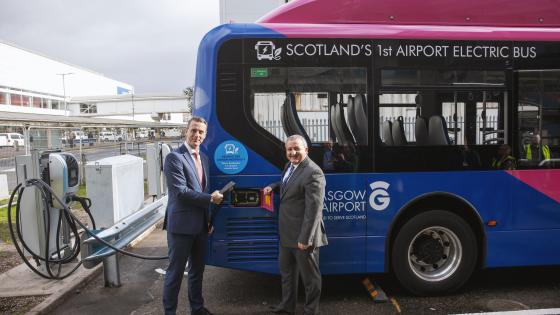
The ADL Enviro200EV combines BYD’s electric driveline and battery technology with Alexander Dennis bodies
Further north, Aberdeen International Airport recently inaugurated an electric bus fleet to transfer passengers between the terminal and car parks. Passengers taking advantage of the airport's free 30-minute drop-off at the Long Stay Car Park are offered use of the zero-emission 22-seater EMV e-Cityline bus for free. Jemma Cummings, head of travel services and commercial products at Aberdeen, said: “By moving to a full-electric bus operation to our car parks, we reduced the carbon emissions associated and this significant reduction is further supported by the fact that the airport’s electricity is also supplied via renewable energy”
Newcastle International Airport became the first in the UK to operate a fully-electric, zero-emission airside bus when it launched the Yutong ABe14 in 2020. Designed to carry 110 passengers, the six opening doors and 258kWh battery offer flexibility and, in many cases, the bus can operate for several days without charging.
New kids on the block
Netherlands-based electric bus manufacturer Ebusco secured its first airport order in the summer of 2023 when it signed a two-year framework with Fraport, operator of Frankfurt Airport, including a fixed order of four Ebusco 3.0 12m buses and options for four more.
For the Ebusco 3.0, a team of experts drew inspiration from the aerospace industry to develop a lightweight and highly efficient electric road vehicle. Due to its composite construction, the bus can drive up to 350km on a single charge of the smallest battery pack available, making it possible to easily run day-to-day airport operations.
Busnex, an EU-based provider of green public transportation solutions, also recently launched its DinoBus as a contender in the fully-electric airport apron bus market. DinoBus’s 14m vehicle has a range of up to 150km and a total passenger capacity of 120 people.
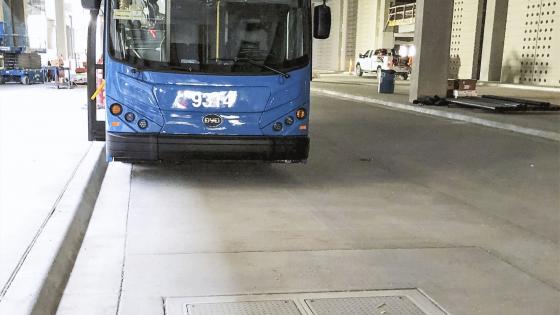
A Kansas City International Airport electric shuttle bus approaches the wireless fast-charging system
Kansas City Aviation Department has invested in the world’s first wireless inductive vehicle charging system at an airport
Across the pond
To gain an insight into how the future of electric airport buses may look, it is helpful to turn to the United States, where the task of making airport vehicles sustainable is being taken extremely seriously. Last summer, near-airport parking specialist The Parking Spot unveiled its first 100% electric shuttle at Los Angeles International Airport (LAX), adding to the current shuttle fleet which runs on compressed natural gas (CNG). The addition of each new electric shuttle will further reduce emissions by an estimated 45,000 lbs annually. Across the entire state of California, airports will be required to exclusively operate zero-emission vehicles by 2035.
Elsewhere, as part of Kansas City International Airport’s $1.5bn New Terminal project, the Kansas City Aviation Department has invested in the world’s first wireless inductive vehicle charging system at an airport. Pennsylvania-based Momentum Dynamics worked on the project to provide frequent incremental charging to the existing electric shuttle buses. While waiting for passengers to board, the vehicles park over the inductive charging pads and automatically charge with very little interaction by the driver. Meanwhile, in Texas, the National Renewable Energy Laboratory (NREL) has developed a simulation-based optimisation modelling framework to help Dallas/ Fort Worth International (DFW) deploy electric buses. The researcher’s model assessed real-world conditions within DFW to determine optimal battery capacity, charging power and number of charging stations, while minimising capital cost and emissions.
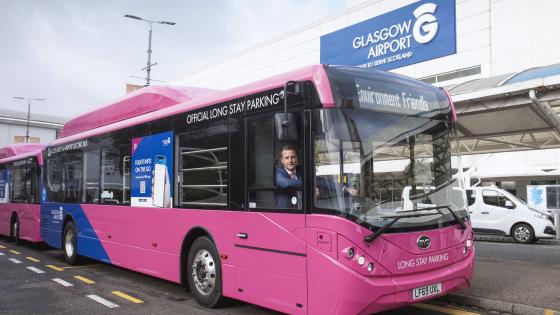
Glasgow was the first UK airport to introduce a fleet of zero-emission electric buses to its car park operation
A winning design
Another new entrant in the electric airport bus market is the COBUS Vega, which won this year’s Red Dot Design Award. The Vega has a modular battery system, comprising two to four NMC3 batteries, and a fast-charging function. Four extra-wide passenger doors on the right-hand side of the bus and three on the left enable faster boarding and uploading. “The jury was impressed by the COBUS Vega’s environmental friendliness, as well as its design language, which breaks with visual norms and sets an unusual stylistic accent,” Red Dot said.
COBUS, which is a prolific supplier of electric airport buses – to Bristol and London Stansted in the UK, as well as Salzburg in Austria – has also unveiled its new fuel-cell bus, the COBUS Hydra, with a refilling time of less than nine minutes and an extended range of up to 400km. The hydrogen-powered Hydra is based on the popular e.COBUS 3000 design and the manufacturer said existing customers have the option of converting their current fleet to hydrogen-power if desired.
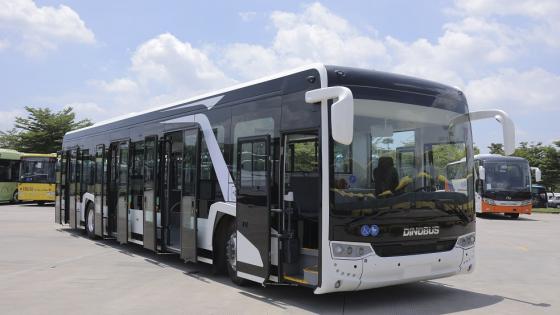
DinoBus’s 14m vehicle has a range of up to 150km
Hydrogen-powered vehicles are being rolled out at Kansai International Airport in Japan
The power of hydrogen
Hydrogen-powered vehicles are also being rolled out at Kansai International Airport in Japan to support a plan to achieve net-zero greenhouse gas emissions by 2050, while ANA-Vinci Airports is considering how to introduce the technology to airports in Portugal in partnership with CaetanoBus. Hydrogen buses typically offer a longer driving range than electric buses, as well as shorter refuelling times.
In France, Airbus has signed a partnership agreement with HyPort, a joint venture between ENGIE Solutions and the Regional Agency for (AREC) to support the development of one of the world’s first low carbon hydrogen production and distribution stations at an airport. The station will have a capacity to produce around 400kg of hydrogen per day, which is enough to power around 50 ground transportation vehicles. Hydrogen-powered buses are also being used to transport passengers to the airport.
Go-Ahead Group is set to add 20 hydrogen-powered buses to routes serving Gatwick Airport and the surrounding areas. The order for single-decker fuel cell buses, manufactured by Wrightbus, has financial backing from the airport. As part of the project, the company will install the UK’s first liquid hydrogen refuelling station for buses.
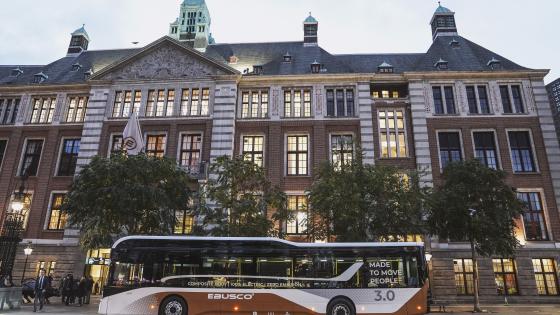
The Ebusco 3.0 has a lightweight composite body based on aerospace technology
Modern materials
Beyond propulsion systems, advances in materials and construction techniques have led to lighter and more aerodynamic bus designs. Composite materials and battery packs with a greater energy density are helping to make buses more efficient, reducing power consumption. Incorporating renewable energy sources within airport infrastructure has also opened novel possibilities for sustainable bus operations, with solar panels and wind turbines an increasingly common feature of the airport environment. Amsterdam’s Schiphol has one of the largest electric bus fleets in Europe, with well over 200 vehicles powered by energy derived from 100% renewable sources, largely wind power. The bus depots too are equipped with solar panels.
New technologies are also changing how electric airport buses are operated. Endera’s fleet of all-electric passenger shuttles for ACE Parking at San Diego International Airport incorporate an AI-driven telematics platform to automate records and reporting. Each vehicle is equipped with an automated passenger counting system that uses cameras and AI algorithms to accurately keep track of passengers and provide detailed reports to the management team. Part of the technology was designed to help combat the spread of COVID-19 by including an infrared camera that reads passengers' temperatures as they board the bus, alerting the driver of an ill passenger. Endera's energy management system also allows fleet operators to easily monitor and manage their vehicles’ charging stations, to minimise energy usage.
